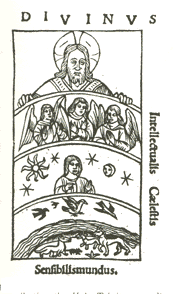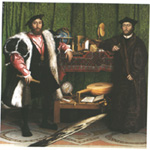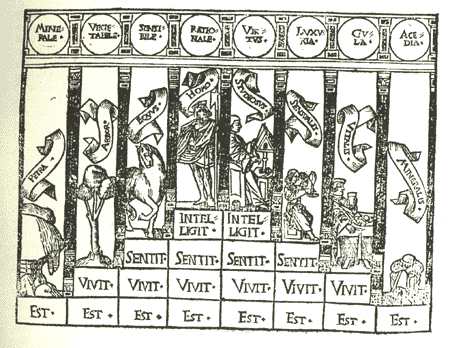

Understanding the inclusion of the Westminster Abbey floor into The Ambassadors as as a reference to the Macrocosm is critical for understanding the meaning of the painting. It establishes a relationship of the men, as signifying the microcosm, to the rest of the painting and to the world as a whole, the macrocosm. This relationship establishes the central position of man in the Renaissance conception of creation. A classic Renaissance statement of this idea is found in the following passage from the Florentine neo-platonist, Marsilio Ficino:
The [Man] is the greatest wonder in nature. All other things under God are always in themselves of one certain kind of being; this [human] essence is at once all of them. It possesses in itself images of the divine things upon which it depends. It also possesses the reasons and models of the inferior things which it in a sense brings forth. Since it is the mean of all things, it possesses the powers of all; hence it transforms itself into all things. And because it is itself the true bond of the universe, in passing into some things it does not forsake the others, but enters into individual things, and at the same time preserves all things. Therefore it can with justice be called the center of nature, the middle point of all that is, the chain of the world, the face of al, and the knot and bond of the universe.*
Through his physical body and sense perception, man participates in the terrestrial realm, and through his intellectual skills, he shares in the super-terrestrial realm of pure intelligence. Man uniquely combines body and soul, matter and intellect, animal and angel. He is neither terrestrial nor super-terrestrial, but a dynamic combination of the two. As noted by Nicholas of Cusa:
Human nature is that [nature] which, though created a little lower than the angels, is elevated above all works of God; it enfolds intellectual and sensible nature and encloses all things within itself, so that ancients were right in calling it a microcosm, or a small world.*
This idea is visually expressed in an illustration from Charles de Bovelles:*

Holbein's placement of the two men in relationship to the table appears to echo this idea.

Dinteville and de Selve bridge the two levels of the table whose lower shelf with the inclusion of the world globe signifies the terrestrial realm while the table top with the astronomical instruments and celestial globe presents the celestial realm.
Because of man's central position in creation, human wisdom is an encyclopedic knowledge of all things. Through his senses, man apprehends the sensible world, and through his intellect, man gains entry into the angelic realm of pure intelligence. Reason serves as a bridge between the senses and the intellect. Nicholas of Cusa writes:
There is no doubt that a human being consists of senses, intellect, and reason (which is in between and which connects the other two). Now, order subordinates the senses to reason and reason to intellect. The intellect is not temporal and mundane butis free of time and of theworld. The senses are temporally subject to the motions of the world. With respect to the intellect, reason is on the horizon, so to speak; but with respecttothe senses, it is at the zenith, as it were; thus, things that are within time and things that are beyond time coincide in reason.*
Sensory knowledge by itself is confused and needs reason to order experience by making distinctions, noting oppositions, and excluding contradictions. Reason produces categories of forms, genera, and species. Intellect transcends these rational categories. In the intellect the distinctions and oppositions articulated by reason become reconciled. In its unifying function, the intellect participates in angelic knowledge and approaches knowledge of divinity. This interrelationship between "sensus," "ratio," and "intellectus" in man's pursuit of knowledge is presented in the following passage from Charles de Bovelles' De sapientia:
...the rational soul first collects notions, species and images of all sensible things in the sublunar world with the help of the body and senses. From these, as the creator of its own species, it constructs, forms, and produces within itself its own proper species, which is the beginning of human wisdom and the soul's knowledge of itself. Then, after attaining self-knowledge, it rises gradually to a simpler and angelic perfection and becomes a participant of angelic knowledge. Finally, ascending still to more sublime things, it finds its consummation in divine cognition and knowledge and participates at last in the truest wisdom.*
Similarly, Nicholas of Cusa writes:
For with sense man measures sensible things, with intellect intelligible things, and attains to what are beyond the intelligible in excess; and he does this according to our premisses, for while he knows the cognoscitive soul is the end of knowable things, he knows the sensitive power that sensible things ought thus to be just as they can be sensed, concerning intelligibles, thuse as they can be understood, concerning those which exceed moreover, thus as they exceed. Hence man finds in himself as if in a measuring reason everything that has been created. *
The Ambassadors should be seen in this hierarchy of knowledge beginning with sense followed by reason and completed by intellectual vision. Each of these levels of knowing can be seen to be alluded to in the painting. Sense is well manifested by Holbein in his attention to detail and the careful differentiation of materials represented. The objects on the top and lower shelves of the table can be seen as the tools associated with the new learning of the period and exemplify the use of the mathematical sciences by man to recreate God's creation through discursive reason. In intellectual vision humans transcend the rational categories.

